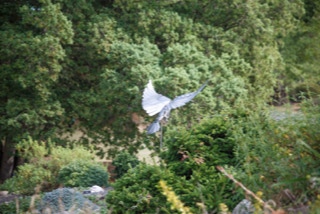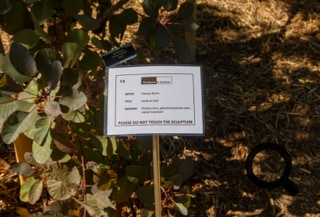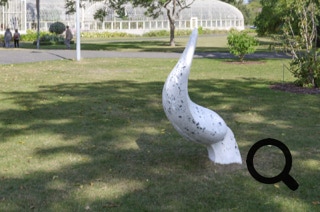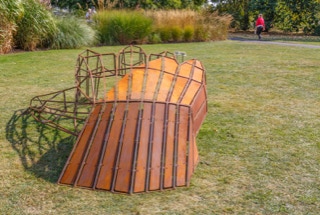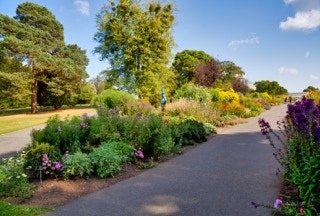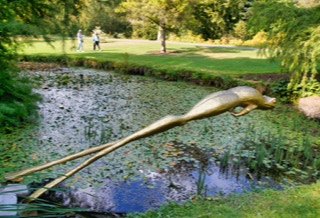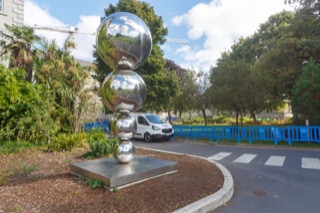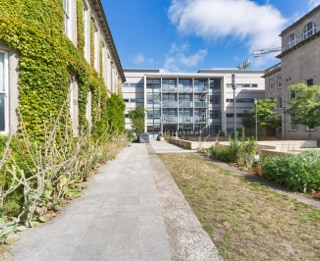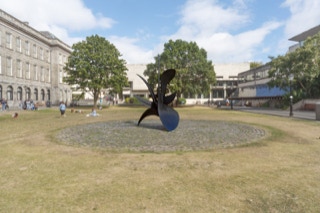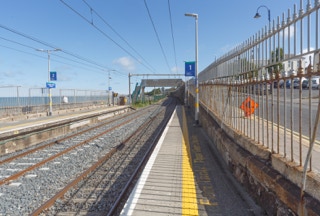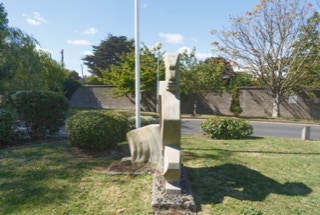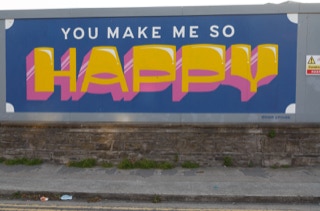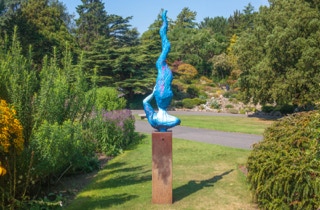The artist is based in Howth and many of his works are made for the garden. He is a member of Ceramics Ireland, Visual Artists Ireland and the Dublin Garden Trail.
01/09/2022
The name is new to me. Nigel Connell Bass is a British artist living in West Cork, Ireland and self-taught in a multitude of disciplines, Nigel is well known for his sculpture work in new and recycled metals, predominantly life-size depictions of birds and animals.
The exhibition began on the first day of September but I visited at the end of August and I used a Canon iDsMKIII camera coupled with a fully manual Voigtlander 40mm pancake lens and I liked the resulting images. The next day when I visited I had had a, newly purchased, Canon 5DIII fitted with the same Voigtlander and the resulting images were unusable because of focusing problems.
On the first of September I used the 5D fitted with a Sigma F4 24-105mm lens. As a result I have decided that using fully manual lenses with the 5D is a waste of time but the same lenses work very well with the 15 year old Canon 1DS MkIII [I do not know why]. The images from the second session are GEO tagged.
01/09/2022
I am aware of this artist because of her Paint-A-Box Street Art located on James Street in Dublin. I have to check my back catalogue but I am almost certain that she had 'Badger' sculpture on display at the Sculpture In Context exhibition in 2022.
01/09/2022
I could be wrong but Ken has had his work on display at every Sculpture In Context exhibition at the Botanic Gardens in Glasnevin.
Kenneth Drew is a practising sculptor with a studio in Ashtown, Dublin. He is also a sculpture tutor at Whitehall College, City of Dublin ETB. He works in a wide range of materials and scales from studio pieces to larger outdoor forms. He exhibits on a regular basis and works on private commissions for medium and larger scale sculptural forms. He has work in the Art for the State Collection and private collections in the US, Netherlands, Kuwait, UK Australia and throughout Ireland.
The Sculpture In Context 2022 exhibition opened to the public on the first Thursday in September at the Botanic Gardens.
01/09/2022
A sculptor and ceramic artist based in Dublin and Galway. At this moment he works mainly in steel, stainless steel and ceramic medium. I am convinced, having seen many examples of his work, that he likes to make large scale interactive pieces that invite a playful side to art.
01/09/2022
Ana Duncan was born in Dublin. She works primarily in bronze and ceramic from her studio in Churchtown. The female figure has constantly been the subject and inspiration for her work. Amongst her influences are the abstraction of Henry Moore, the voluminous figures of Fernando Botero, Barbara Hepworth’s modernist work, the simplicity of Brancusi and the sculptures of Juan Muñoz among others.
She has recently completed several large scale public commissions in Jiangsu, China. In 2015 she completed a large-scale stainless steel public sculpture in Nashua, New Hampshire, USA. Other public commissions include a life size Mother and Child for Tallaght Hospital, Dublin.
01/09/2022
CATALOGUE ITEM: 92
Ayelet Lalor is an Irish based artist specialising in decorative and colourful figurative sculpture and graphic art, and has worked in clay, bronze, concrete and even edible materials.
Born in 1974, Ayelet studied at Grennan Mills Craft School, Glasgow School of Art, and NCAD, Dublin, graduating with a BA in 1996, and MA in 2009. She was surrounded by independent, free thinking women growing up. This has shaped her work greatly, the strong female form being central to her artwork, embellished by strong decorative aspects of colour, pattern and texture.
Her work has been commissioned both publicly and privately, and collections include the OPW, The Irish Embassy in London, Mason, Hayes and Curren and Limerick City Gallery. She has exhibited at the Philadelphia Museum of Art Crafts Fair, the National Museum of Ireland, Gormleys Fine Art, Sculpture in Context, the RDS National Craft Awards, The Millcove Gallery and Farmleigh among numerous others, in Ireland and abroad.
01/09/2022
CATALOG ITEM: 76
Petr Holecek was born in 1976 in Benesov, Czech Republic.
Between the years 1996 to 2001 he studied at University in Ceske Budejovice, CR, Pedagogical Faculty, and specialized in Art and Civic Education. In the Spring of 2003 he attended a drawing studies course at the National Gallery of Ireland, and in 2004 he was an art assistant in the studio of Patrick O’Reilly in Dublin
He has had many solo exhibitions in the Czech Republic and numerous group exhibitions throughout Ireland including a solo show at The Kildare Gallery in 2018.
01/09/2022
SCULPTURE IN CONTEXT
Catalog Ref:19
Born in Barcelona, Mercè Cañadell studied Ceramics and Sculpture in Massana School of Art & Design from 1990-93.
Since then she has continued studying different techniques and the use of different materials, covering mould making, sculptural ceramics, carved wood and painted textiles.
She has been in Ireland since 2002.
An important part of her artistic development involved metal work and casting bronze in Barcelona and in Dublin. She is an artist that enjoys working in different media. Her sculptures in bronze and ceramics have been exhibited regularly in galleries throughout Ireland and Dublin.
30/08/2022
As I used a wide-angle zoom lens there is a degree of distortion in the images.
Before the Ha'penny Bridge was built there were seven ferries, operated by a William Walsh, across the Liffey. The ferries were in a bad condition and Walsh was informed that he had to either fix them or build a bridge. Walsh chose the latter option and was granted the right to extract a ha'penny toll from anyone crossing it for 100 years.
Initially the toll charge was based not on the cost of construction, but to match the charges levied by the ferries it replaced. A further condition of construction was that, if the citizens of Dublin found the bridge and toll to be "objectionable" within its first year of operation, it was to be removed at no cost to the city.
The toll was increased for a time to a penny-ha'penny (1½ pence), but was eventually dropped in 1919. While the toll was in operation, there were turnstiles at either end of the bridge.
The manufacture of the bridge was commissioned by the then Lord Mayor of Dublin, John Claudius Beresford with the Coalbrookdale Company of England. Using ore originally mined in County Leitrim's Sliabh an Iarainn, the bridge's cast iron ribs were made in 18 sections and then shipped to Dublin. The design and erection was supervised by John Windsor, one of the company's foremen and a pattern-maker.
In 2001 the number of pedestrians using the bridge on a daily basis was 27,000 and, given these traffic levels, a structural survey indicated that renovation was required. The bridge was closed for repair and renovations during 2001 and was reopened in December 2001, sporting its original white colour.
The structure was rebuilt to retain many of its old components, although, controversially, some features were removed. The repair work was carried out by Harland and Wolff.
In 2012, citing a maintenance and damage risk, Dublin City Council removed a number of love locks from the Ha'penny Bridge and nearby Millennium Bridge, and asked people not to add any more. In 2013 the council removed over 300 kg of locks from the bridge, and signage was added asking people not to put padlocks on the bridge.
30/08/2022
Apples and Atoms by Eilís O’Connell RHA Celebrating Ernest T.S. Walton 1903-95, Nobel Laureate
In 1932, Ernest Walton and John Cockcroft split the nucleus of a Li (lithium) atom, often termed ‘splitting the atom’. The experiment was carried out in the Cavendish Laboratory at the University of Cambridge, England. Albert Einstein declared that their experiment was the first demonstration of his famous E=mc2 equation.
Commemorating the 80th anniversary of the experiment, Trinity College Dublin invited six artists to submit a design responding to a brief to commemorate Ernest Walton’s research achievements as well as over 30 years of dedication to science education. Eilís O’Connell’s design was selected by an interdisciplinary panel including representatives from the Walton family, the School of Physics, the College Art Collections, the students, and external visual arts professionals.
Ernest Thomas Sinton Walton (6 October 1903 – 25 June 1995) was an Irish physicist and Nobel laureate. He is best known for his work with John Cockcroft to construct one of the earliest types of particle accelerator, the Cockcroft–Walton generator. In experiments performed at Cambridge University in the early 1930s using the generator, Walton and Cockcroft became the first team to use a particle beam to transform one element to another. According to their Nobel Prize citation: "Thus, for the first time, a nuclear transmutation was produced by means entirely under human control."
30/08/2022
This garden is new garden is located in a newly developed square just outside the Botany Department.
HRH Princess Maha Chakri Sirindhorn visited the Trinity College Campus 06 September 2014 and my two friends from Thailand were more than excited.
Thailand’s biodiversity can be considered a world heritage possession. Fifty years ago, in 1963, the ‘Flora of Thailand’ project was initiated under Thai-Danish collaboration. The aim was to produce a complete account of all the native vascular plants of Thailand. In 1985, Trinity joined this project. Since then the plant systematics research group in Trinity’s herbarium has made major contributions to the project with the discovery and publication of very many species new to science.
One of these new shrubs has recently been named Buxus sirindhorniana, in honour of Her Royal Highness. The naming of this shrub is particularly appropriate because Her Royal Highness has a life-long interest in the natural world and in the conservation and study of biodiversity. And she is a long-term advocate of sustainable development.
30/08/2022
Alexander Calder 'Cactus Provisoire' (1967) - welded steel. This is located on the Fellows’ Square at Trinity College in Dublin.
Alexander Calder (July 22, 1898 – November 11, 1976) was an American sculptor known both for his innovative mobiles (kinetic sculptures powered by motors or air currents) that embrace chance in their aesthetic, his static "stabiles", and his monumental public sculptures. Calder preferred not to analyse his work, saying, "Theories may be all very well for the artist himself, but they shouldn't be broadcast to other people."
30/08/2022
The Blackrock baths were provided for by the railway company in 1839 and were built beside the Blackrock train station. A special train ticket also permitted entrance to the baths. In 1887, the baths were rebuilt in concrete with a large gentlemen's bath and a smaller ladies' bath. In 1928, the Urban District Council bought the baths for £2,000 and readied them for the Tailteann Games. The baths, with a 50-metre pool, were well known for their swimming galas and water polo and could accommodate up to 1,000 spectators."
Eddie Heron lived in Sandycove and is known for his achievement as 36 years undefeated Springboard and Highboard Diving Champion of Ireland. A plaque commemorating him is on the railway bridge that crosses over to the baths.
On 11 September 1891, Thomas Crean, while swimming with fellow students near Blackrock, helped rescue a 21-year-old art student named William Ahern. Crean noticed that Ahern was in trouble and together with a young solicitor named Leachman from Dundrum, he managed to bring him ashore. For his bravery, he was awarded a medal by the Royal Humane Society.
The decline in the use of the baths started in the 1960s when indoor heated swimming pools started to appear. Dún Laoghaire Corporation closed the Blackrock Baths in the late 1980s and by 1992, due to lack of maintenance, parts of the baths were dismantled.[ They have since been sold to developers Treasury Holdings.[18] In 2013, the baths were demolished due to safety concerns following a routine inspection by Dún Laoghaire–Rathdown County Council. It was found that the diving platform had been significantly corroded and detached from the pool base.
30/08/2022
Today I used a Canon 5DMkIII coupled with a very old Sigma 12-24 lens. I originally purchase the Sigma 12-24 to use with my original Canon 5D back in 2005 or 2006 and I was somewhat disappointed because of distortion and unacceptable amounts of lens flare. I tried using it with my first Sony 7R and it performed badly so I more-or-less put it on a high shelf and forgot about it.
Today the lens performed much better than I had expected but lens flare was, without doubt, an issue but in most cases I was able to compensate in post-production.
Pearse railway station or Dublin Pearse is a railway station on Westland Row on the Southside of Dublin, Ireland. It is Ireland's busiest commuter station and second busiest station overall (behind Dublin Connolly railway station) with 9 million passenger journeys through the station in 2016.
The station was renamed in 1966, when several Irish railway stations were renamed as part of the Easter Rising 50th-anniversary celebrations, after the Pearse brothers, Patrick and Willie. Probably due to confusion with the nearby Pearse Street, Dubliners often refer to it as "Pearse Street station". My Grandmother always referred to it as Westland Row Station and it should be mentioned that I was baptised in the church beside the station.
Major renovation commenced in 2007 with publicity erected in the station for this in March 2008. As part of phase 1, automatic ticket validation machines were installed on platforms 1 and 2. The front entrance of the station was changed. The former Spar shop was completely taken out of the station and the old ticket barriers were removed. Platforms 3, 4 and 5 were removed. New signage and CCTV cameras were added on both active platforms and, on Platform 2, a larger waiting area for passengers was provided.
An additional Southbound entrance (Pearse Street and Trinity Bio Science) was opened 9 April 2013. At the official opening of the entrance by Minister Leo Varadkar the National Transport Authority used the term Pearse Street Station in the title of a page on its website although there was no evidence of any official renaming.
30/08/2022
St Kilian's German School (Deutsche Schule Dublin - DSD) is an independent German international school in Dublin, Ireland.
St Kilian's was founded in the early 1950s, developing from the work of a Dublin charity, the Save the German Children Society, founded in 1945.
Since 2002, St Kilian's has shared sites with Lycée Française d'Irlande, the combined campus known as the "Eurocampus".[
The secondary school has a typical rate of progression to third-level of 90-100%. In 2020 this reduced to 63%, following
Kilian, also spelled Killian, was an Irish missionary bishop and the Apostle of Franconia (Franconia is nowadays the northern part of Bavaria), where he began his labours in the latter half of the 7th century. His feast day is 8 July.
The Kiliani-Volksfest, which runs for two weeks every July, is the main civil and religious festival in the region around Würzburg, Germany.
St Killian's College, Garron Tower, Northern Ireland is named for him. Also, St. Kilian's Heritage Centre, located in the village of Mullagh in County Cavan. It was opened in 1995 by the then President of Ireland, Mary Robinson. Built by the local community in association with the Diocese of Würzburg in southern Germany, the Heritage Centre features many relics and replicas of the saint. The German School in Dublin, Ireland, is named after St. Kilian as a tribute to the early exchange of education between the two countries of Ireland and Germany.
There are religious buildings which bear his name as well: St. Kilian's Abbey, Würzburg and St. Kilian's Church, Heilbronn are two such places. Also there is a basic school in Ghana named after him and also a parish church in Mission Viejo, California. Also a parish in Farmingdale, New York.
29/08/2022
This collection of street art, featuring the work of twenty artists, was organised by BoomBox and Dublin City Council.
I need to check my previous photographs but I am fairly certain that there have been no additions to this urban gallery since late September 2021 which is almost a year ago.
29/08/2022
The new Printmaking Workshop in Grangegorman was shortlisted for the Institute of Designers Ireland awards.
The single storey steel framed building was designed by Scullion Architects in association with Plus Architecture and details a saw-tooth profile roof structure with integrated windows at each section and roof solar panels. The light filled internal space provides teaching and technical support spaces associated with print making and screen printing for the Technological University Dublin’s School of Creative Arts.
Today [29 August 2022] I used a Canon 5DIII coupled with a Sigma 24-105 F4 lens and when I imported the images into Lightroom I was surprised by the amount of lens barrel distortion but it was easy to correct. I checked some reviews and some mention that barrel distort is high at 24mm.
The first good camera that I purchased was the Canon 5D and to the best of my knowledge it was delivered in January 2006. Before that I had a Sigma DSLR and it was a disaster.
Today my dealer contacted me to inform me that a customer wished to trade in a Canon 5D III that was never used [it was a prize] because he was a Fuji user. I had a look at the camera today and it looked brand new so I purchased it at a very good price on condition that a GPS unit was included [the GPS is due to arrive later this week].
29/08/2022
This is a preview as the exhibition does not begin until next Thursday [1 September 2022]
Sculpture in Context is the longest running, most prestigious sculpture exhibition in Ireland. Staged annually in the National Botanic Gardens in Dublin, this unique exhibition showcases the inspiring and extraordinary work of both established and emerging artists throughout the magnificent 50 acres of landscaped gardens located in Glasnevin, just three kilometres from Dublin City Centre.
The first good camera that I purchased was the Canon 5D and to the best of my knowledge it was delivered in January 2006. Before that I had a Sigma DSLR and it was a disaster.
I am going through a phase of using old DSLR cameras, mainly because I have a collection of Canon FE mount lenses. Today I used a Canon 1Ds MkIII. This body was purchased about 15 years and there was an auto-focus problem which I did not discover for about a year after buying the camera because I had thought that my lack of skill and knowledge was the problem. At the time I had a Canon 5D which I used rather than the 1DS but I eventually switched to Sony mirrorless. I sold the 5D at a very good price but no one was interested in the 1Ds. A few years ago a friend offered me a number of Canon EF lenses at a very good price so I purchased them. A few weeks later my local dealer offered me a slightly used Voigtlander 40mm pancake lens at an amazing price and I soon discovered that I really liked it so I began using the 1Ds in manual mode. The one major problem was that the camera had no GPS capability which makes it somewhat unattractive for me when I travel.
Today my dealer contacted me to inform me that a customer wished to trade in a Canon 5D III that was never used [it was a prize] because he was a Fuji user. I had a look at the camera today and it looked brand new so I purchased it at a very good price on condition that a GPS unit was included [it is due to arrive later this week].
I will visit Kilkenny in two weeks and I will depend on the Canon 5D III.





